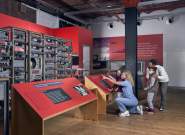Create lasting memories with our guide to family-friendly attractions in Manchester. From…
Discover Manchester's culinary delights with our Restaurants guide. From cosy neighbourhood…
From arts and exhibitions to comedy and entertainment, Manchester offers a fantastic number of…
Buy the Visit Manchester Pass
Discover Manchester with the Visit Manchester Pass - Entry into 13 of Manchester's top attractions plus over 30 discounts and offers.







